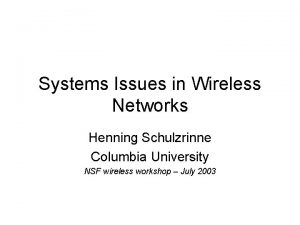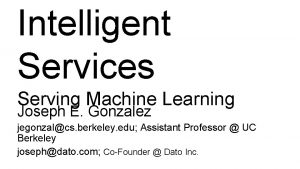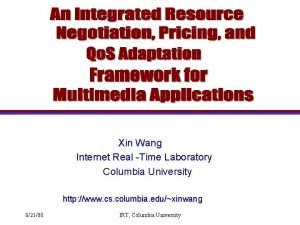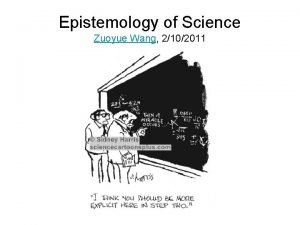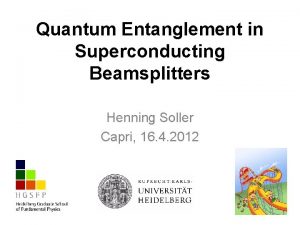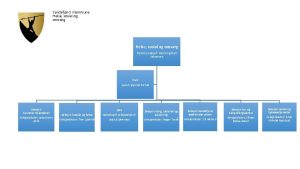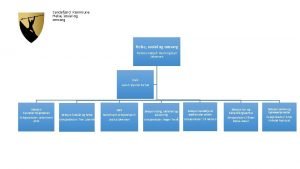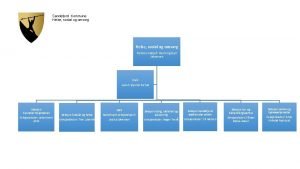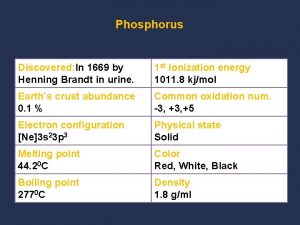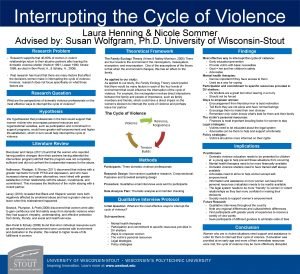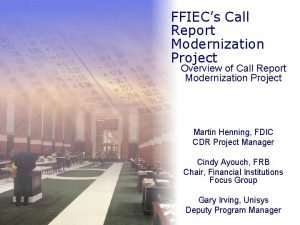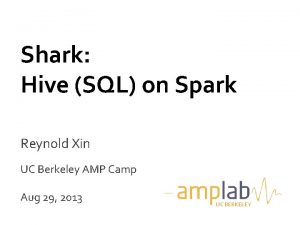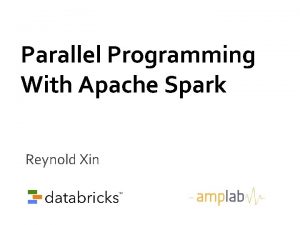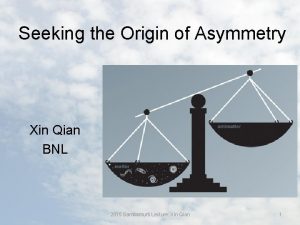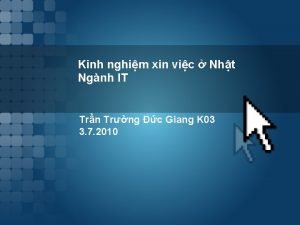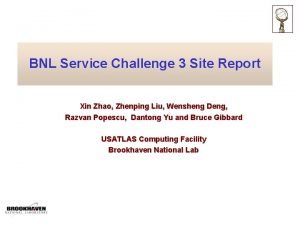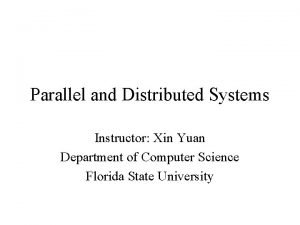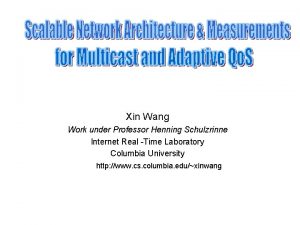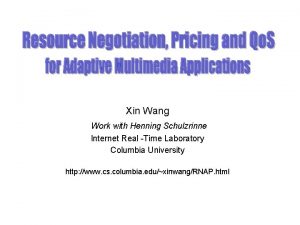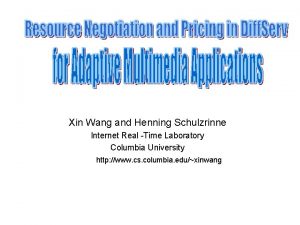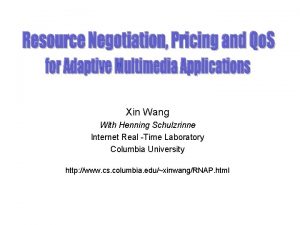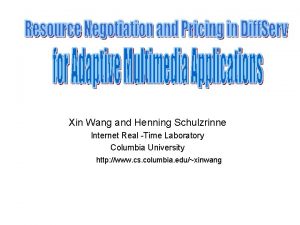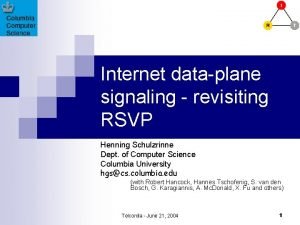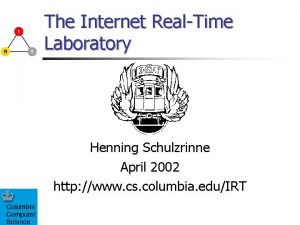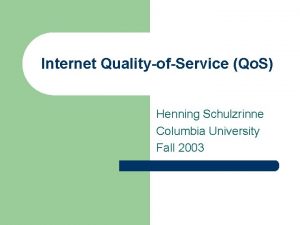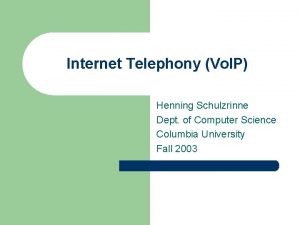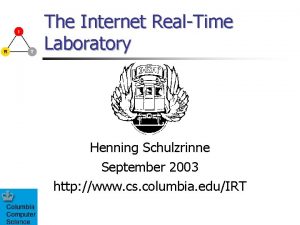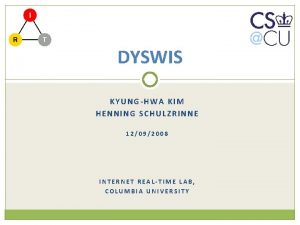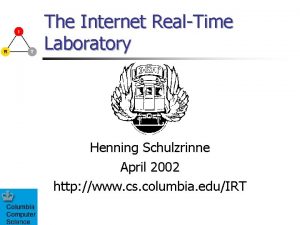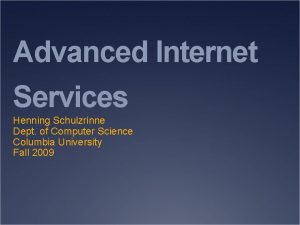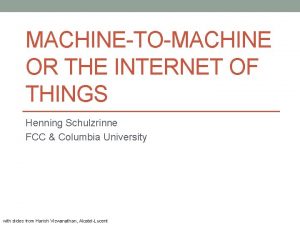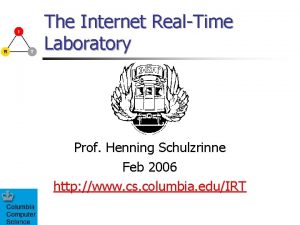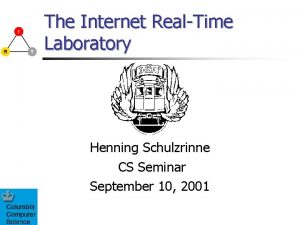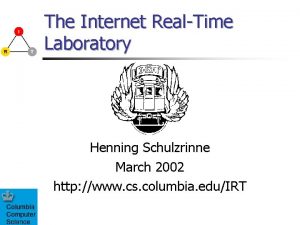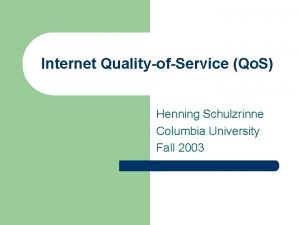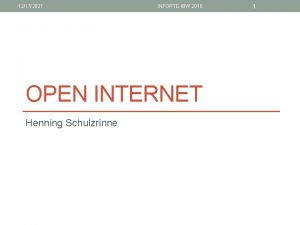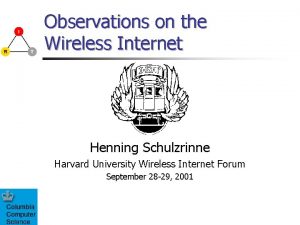Xin Wang Work under Professor Henning Schulzrinne Internet

































































- Slides: 65

Xin Wang Work under Professor Henning Schulzrinne Internet Real -Time Laboratory Columbia University http: //www. cs. columbia. edu/~xinwang

Scope of this Talk n Main work u n Resource Negotiation, Pricing, and Qo. S for Adaptive Multimedia Applications Other work u Measurements and Analysis of LDAP Performance u IP Multicast Fault Recovery in PIM over OSPF 10/26/2021 Xin Wang, Columbia University 2

Xin Wang With Henning Schulzrinne Internet Real -Time Laboratory Columbia University http: //www. cs. columbia. edu/~xinwang/RNAP. html

Today’s IP Networks Service Level Agreements (SLA) are negotiated based on Application Specific Needs Regional Networks bandwidth, loss, delay, jitter, availability, price A pp lic Regional Networks Application SLA Backbone at io n SL A Network Regional Networks 1. Growth of new IP services and applications with different bandwidth and quality of service requirements 2. Revenue from the traditional connectivity services is declining 3. New services present opportunities and challenges for service providers 10/26/2021 Xin Wang, Columbia University 4

The Needs of Next Generation Service Providers n Increase revenue by offering innovative services u Vo. IP, VPN, Applications Hosting, etc u Deliver high-margin, differentiated services n n Gain competitive advantage - rapidly deploy and scale new services Meet service expectations of diverse services: u Over-provision - add enough raw bandwidth to backbone and access networks AND/OR u Provision and manage network more efficiently (greater automation, dynamic provisioning) 10/26/2021 Xin Wang, Columbia University 5

NORDUnet Traffic Analysis 10/26/2021 Xin Wang, Columbia University 6

NORDUnet Traffic Analysis (cont’d) n Results: u All access links (interconnect ISP’s or connect private networks to ISP’s, trans-Atlantic links) can get congested. u Average utilization is low: 20 -30% u Peak utilization can be high: up to 100% è Congestion Ratio (peak/average): as high as 5. u Peak duration can be very long: è Chicago NAP congested once in 8/00, lasted 7 hours. è Tele. Globe links congested every workday in 8/00 and 9/00 10/26/2021 Xin Wang, Columbia University 7

Bandwidth Pricing n Reality: leased bandwidth price has not been dropping consistently and dramatically. u 300 mile T 1 price: è 1987: $10, 000/month è 1992: $4, 000/month è 1998: $6, 000/month (thanks to high Internet demand) u Links connecting ISP’s are very expensive è Transit u DS-3 link: $50, 000/month between carriers. è Transit OC-3 link: $150, 000/month between carriers. Cost of fiber optics is declining. But network management costs - switches and routers, state of the art POP, data centers - are high. Bandwidth may be cheap, but not free Higher-speed connection -- higher recurring monthly costs. 10/26/2021 Xin Wang, Columbia University 8

Is Simple Over-Provisioning Enough? n n Even though average bandwidth utilization is low, congestion can happen; access links get congested frequently Wireless bandwidth is even more scarce Bandwidth prices are not dropping rapidly No intrinsic upper limit on bandwidth use Option - manage the existing bandwidth better, with a service model which uses bandwidth efficiently. 10/26/2021 Xin Wang, Columbia University 9

A More Efficient Service Model n Quality of Service (Qo. S) u Condition the network to provide predictability to an application even during high user demand u Provide multiple levels of services u How to manage multiple service more efficiently? How much to charge a service? n Application adaptation u Source rate adaptation based on network conditions congestion control and efficient bandwidth utilization u Best effort service u Why would an application adapt? 10/26/2021 Xin Wang, Columbia University 10

A More Efficient Service Model (cont’d) n Requirements of Qo. S/adaptive model: u u u n n mechanism to select and negotiate services adaptive applications Allow dynamic resource short-term resource configuration for better negotiation during response to user demand network ongoing service conditions, for more efficient resource usage price network services based on Qo. S (resources consumed), allocate resources based on user willingness-to-pay provide signal / incentive for user adaptation through pricing A dynamic service selection and resource negotiation mechanism Usage-, Qo. S-, demand-sensitive pricing 10/26/2021 Xin Wang, Columbia University 11

What We Add to Enable This Model n A dynamic resource negotiation protocol: RNAP u u u u n An abstract Resource Negotiation And Pricing protocol Enables user and network (or two network domains) to dynamically negotiate multiple services Includes mechanisms for price and charge collation, auction bids and results distribution Service predictability: commit service and price for an interval Multi-party negotiation: senders, receivers, or both Reliable and scalable Lightweight and flexible: embedded in other protocols, e. g. , RSVP, or implemented independently A demand-sensitive pricing model u u 10/26/2021 Enables differential charging for supporting multiple levels of services; services priced to reflect the cost and long-term user demand Allows for congestion pricing to motivate user adaptation Xin Wang, Columbia University 12

What We Add. . . (cont’d) n n Demonstrate a complete resource negotiation framework (RNAP, pricing model, user adaptation) on test-bed network Show significant advantages relative to static resource allocation and fixed pricing using simulations: u Much lower service blocking rate under resource contention u Service assurances under large or bursty offered loads, without highly conservative provisioning u Higher perceived user benefit and higher network revenue 10/26/2021 Xin Wang, Columbia University 13

Outline n n n Background RNAP: architecture and messaging Pricing models: u Comparison of models u Proposed pricing model n n n Resource Negotiation Framework User adaptation Testbed demonstration of Resource Negotiation Framework Simulation and discussion of Resource Negotiation Framework 10/26/2021 Xin Wang, Columbia University 14

Protocol Architectures: Centralized (RNAP-C) Host Resource Negotiator NRN HRN RNAP Messages Network Resource Negotiator NRN HRN Access Domain - A Edge Router Internal Router 10/26/2021 Access Domain - B Transit Domain Intra-domain messages Xin Wang, Columbia University 15

Protocol Architectures: Distributed (RNAP-D) RNAP Messages HRN LRN Local Resource Negotiator LRN Access Domain - A LRN LRN LRN 10/26/2021 LRN LRN HRN LRN Edge Router Internal Router LRN Access Domain - B Transit Domain Xin Wang, Columbia University 16

RNAP Messages Query: Inquires about available services, prices Periodic negotiation Query Quotation: Specifies service availability, accumulates service statistics, prices Commit Reserve: Requests services and resources, Modifies earlier requests Reserve Quotation Reserve specific price or denies it. Commit Close Release 10/26/2021 Commit: Confirms the service request at a Close: Tears down negotiation session Release: Releases the resources Xin Wang, Columbia University 17

Message Aggregation (RNAP-D) Turn on router alert Turn off router alert Edge Routers Sink-tree-based aggregation 10/26/2021 Xin Wang, Columbia University 18

Message Aggregation (RNAP-D) Turn off router alert Turn on router alert Sink-tree-based aggregation 10/26/2021 Xin Wang, Columbia University 19

Message Aggregation (RNAP-C) NRN 10/26/2021 Sink-tree-based aggregation Xin Wang, Columbia University 20

Block Negotiation (Network-Network) Bandwidth Aggregated resources are added/removed in large blocks to minimize negotiation overhead and reduce network dynamics time 10/26/2021 Xin Wang, Columbia University 21

Outline n n n Background RNAP: architecture and messaging Pricing models: u Comparison of models u Proposed pricing model n n n Resource Negotiation Framework User adaptation Testbed demonstration of Resource Negotiation Framework Simulation and discussion of Resource Negotiation Framework 10/26/2021 Xin Wang, Columbia University 22

Pricing in Current Internet n Access-rate-dependent flat charge u u u n Usage-based charge u u n Simple, price predictable Difficult to compromise between access speed and cost No incentive for users to limit usage congestion Volume-dependent charge Time-base charge è works better for uniform per-time unit resource demands, e. g. , telephone Access charge + Usage-based charge u u Per-hour charge after certain period of use, or per-unit charge after some amount of traffic transmitted. Flat charge for basic service, usage charge for extra bandwidth or premium services 10/26/2021 Xin Wang, Columbia University 23

Two Volume-based Pricing Strategies n Fixed-Price (FP): fixed unit volume price u During congestion: higher blocking rate OR higher dropping rate and delay n Congestion-dependent-Price (CP): FP + congestionsensitive price component u During congestion: users have options to maintain service by paying more OR reducing sending rate OR switching to lower service class u Overall reduced rate of service blocking, packet dropping and delay 10/26/2021 Xin Wang, Columbia University 24

Important Time Scales Technical levels of interaction Monetary levels of interaction 10/26/2021 Xin Wang, Columbia University c Pla ity nn ing pa Ra tes Ca at Co n time Fl so u Re rce ser va tio n medium-term long-term Re Fe cin Ro g uti n Sc g he du Er lin g ro r. H an dli Po li ed b Flo ack w Co Re ntr tra o nsm l iss ion short-term ng atomic ng Pr esti i Ti cing on m eo Pr f-d ici ay ng n 25

Proposed Pricing Strategies n Holding price and charge: based on cost of blocking other users by holding bandwidth even without sending data u n Usage price and charge: maximize the provider’s profit, constrained by resource availability u u n phj = j (pu j - pu j-1) , chij (n) = ph j r ij (n) j max [Σl x j (pu 1 , pu 2 , …, pu. J ) puj - f(C)], s. t. r (x (pu 2 , …, pu. J )) R cuij (n) = pu j v ij (n) Congestion price and charge: drive demand to supply level (two mechanisms) 10/26/2021 Xin Wang, Columbia University 26

Usage Price for Differentiated Service n Usage price based on cost of class bandwidth: u lower target load (higher Qo. S) -> higher per-unit bandwidth price n Parameters: u u u n n n pbasic rate for fully used bandwidth j : expected load ratio of class j xij : effective bandwidth consumption of application i Aj : constant elasticity demand parameter Price for class j: puj = pbasic / j Demand of class j: xj ( puj ) = Aj / puj Effective bandwidth consumption: xe j ( puj ) = Aj / ( puj j ) Network maximizes profit: u max [Σl (Aj / pu j ) pu j - f (C)], puj = pbasic / j , s. t. Σl Aj / ( pu j j ) C Hence: pbasic = Σl Aj / C , puj = Σl Aj /(C j) 10/26/2021 Xin Wang, Columbia University 27

Congestion Price: First Mechanism Tatonnement n Tatonnement process (CPA-TAT): u Congestion charge proportional to excess demand relative to target utilization u pc j (n) = min [{pcj (n-1) + j (Dj, Sj) x (Dj-Sj)/Sj, 0 }+, pmaxj ] u ccij (n) = pc j v ij (n) 10/26/2021 Xin Wang, Columbia University 28

Congestion Price: Second Mechanism M-bid Second-price Auction n Auction models in literature: u u u n Assume unique bandwidth/price preference, one bid Service uncertainty: user does not know about high demand until rejected Other issues: setup delay, signaling burst, user response to auction results M-bid auction Model u u u User bids (bandwidth, price) for a number of bandwidths, bids obtained by sampling utility function. Reduce uncertainty Network selects highest bids, charges highest rejected bid price During high demand: lower bandwidth (higher price per unit bandwidth) bids get selected; more users served Periodic auctions - support congestion control Inter-auction admission to reduce setup delay 10/26/2021 Xin Wang, Columbia University 29

Example of M-bid Auction n Total capacity 70, congestion price is 2 Bid Price 5 4 4 3. 5 3 2 Bid Bandwidth Bidder Bid Selection 10 10 15 20 25 1 2 1 3 2 30 3 Cutoff Congestion Price 10/26/2021 Xin Wang, Columbia University 30

Outline n n n Background RNAP: architecture and messaging Pricing models: u Comparison of model u Proposed pricing model n n n Resource Negotiation Framework User adaptation Testbed demonstration of Resource Negotiation Framework Simulation and discussion of Resource Negotiation Framework 10/26/2021 Xin Wang, Columbia University 31

Rate Adaptation of Multimedia System n Utility/cost/bud n Gain optimal perceptual value of the system based on the network conditions and user profile Utility function: users’ preference or willingness to pay U 1 U 2 U 3 get 10/26/2021 Cost Budget Bandwidth Xin Wang, Columbia University 32

Example Utility Function n Utility is a function of bandwidth at fixed Qo. S example utility function: U (x) = U 0 + log (x / xm) u U 0 : perceived (opportunity) value at minimum bandwidth u : sensitivity of the utility to bandwidth u An n Function of both bandwidth and Qo. S (x) = U 0 + log (x / xm) - kd d - kl l , for x xm u kd : sensitivity to delay u kl : sensitivity to loss u. U 10/26/2021 Xin Wang, Columbia University 33

Two Rate-Adaptation Models n Model 1: User adaptation under CPA-TAT (tatonnementbased pricing) u u n Optimize perceived surplus of the multimedia system subject to budget and application requirements With the example utility functions, resource request of application i: è Without budget constraint: x i = i / pi è With budget constraint: x i = bi / pi, with b i = b ( i / Σl k ) Model 2: User adaptation under CPA-AUC (second-price auction) u Submit M-bid derived by sampling utility function; adapt rate based on allocated bandwidth/Qo. S 10/26/2021 Xin Wang, Columbia University 34

Stability and Oscillation Reduction n n Congestion-sensitive pricing has been shown to be stable Oscillation reduction u Users: re-negotiate only if price change exceeds a given threshold u Networks: update price only when traffic change exceeds a threshold; negotiate resources in larger blocks between domains 10/26/2021 Xin Wang, Columbia University 35

Outline n n n Background RNAP: architecture and messaging Pricing models: u Comparison of model u Proposed pricing model n n n Resource Negotiation Framework User adaptation Testbed demonstration of Resource Negotiation Framework Simulation and discussion of Resource Negotiation Framework 10/26/2021 Xin Wang, Columbia University 36

Testbed Architecture RAT VIC n Mbus n HRN RN AP NRN n n 10/26/2021 Demonstrate functionality and performance improvement: u blocking rate, loss, delay, price stability, perceived media quality Host u HRN negotiates for a system u Host processes (HRN, VIC, RAT) communicate through Mbus Network u Router: Free. BSD 3. 4 + ALTQ 2. 2, CBQ extended for Diff. Serv u NRN: (1) Process RNAP messages; (2) Admission control, monitor statistics, compute price; (3) At edge, dynamically configure the conditioners and form charge Inter-entity signaling: RNAP Xin Wang, Columbia University 37

Functions of Routers n Interior routers: per-class policing, e. g, TBMETER (in/out) for a class n Edge routers: flow conditioning/policing based on SLA 10/26/2021 Xin Wang, Columbia University 38

Functions of Network Resource Negotiator (NRN) n Process RNAP messages Monitor statistics and provide price for each service class n Measurement-based admission control n u predict future demand, update congestion price based on predictions 10/26/2021 Xin Wang, Columbia University 39

Network States n n Per-class bandwidth and price variations Reduction in blocking due to adaptation 10/26/2021 Xin Wang, Columbia University 40

Outline n n n Background RNAP: architecture and messaging Pricing models: u Comparison of model u Proposed pricing model n n n Resource Negotiation Framework User adaptation Testbed demonstration of Resource Negotiation Framework Simulation and discussion of Resource Negotiation Framework 10/26/2021 Xin Wang, Columbia University 41

Simulation Design n Performance comparison: u u n Four groups of experiments: u n Network with dynamic service negotiation and rate-adaptive users vs. network with non-adaptive users Fixed price policy (FP) (usage price + holding price) versus congestion price based adaptive service (CPA) (usage price + holding price + congestion price) (1) Effect of traffic load; (2) Effect of admission control ; (3) Effect of traffic burstiness; (4) Load balance between classes; Engineering metrics: bottleneck traffic arrival rate, average packet loss and delay, user request blocking probability n Economic metrics: average and total user benefit, end-to-end price and its standard deviation, network revenue 10/26/2021 Xin Wang, Columbia University 42

Simulation Models n n n Network Simulator (NS-2) Weighted Round Robin (WRR) scheduler Three classes: EF, AF, BE u EF: tail dropping, load threshold 40%, delay bound 2 ms, loss bound 10 -6 u AF: RED-with-In-Out (RIO), load threshold 60%, delay bound 5 ms, loss bound 10 -4 u BE: Random Early Detection (RED), load threshold 90%, delay bound 100 ms, loss bound 10 -2 Sources: mix of on-off traffic and Pareto on-off traffic (shape parameter: 1. 5) Negotiation period: 30 s, session length 10 min 10/26/2021 Xin Wang, Columbia University 43

Simulation Architecture Topology 1 (60 users) 10/26/2021 Topology 2 (360 users) Xin Wang, Columbia University 44

Effect of Traffic Load Average packet delay 10/26/2021 Average packet loss Xin Wang, Columbia University 45

Effect of Admission Control Average packet delay 10/26/2021 Average packet loss Xin Wang, Columbia University 46

Effect of Admission Control (cont’d) Average price and standard deviation 10/26/2021 Blocking rate Xin Wang, Columbia University 47

Effect of Admission Control (cont’d) Network revenue 10/26/2021 Average user benefit Xin Wang, Columbia University 48

Effect of Traffic Burstiness Average packet delay 10/26/2021 Average packet loss Xin Wang, Columbia University 49

Load Balance Between Classes Average packet delay 10/26/2021 Average packet loss Xin Wang, Columbia University 50

Simulation Results n n n Congestion-price-based policy (CPA) + user adaptation vs Fixed price policy (FP) + no adaptation: u limit congestion u lower request blocking rate, u higher user satisfaction u higher network revenue Differentiated service requires different target loads in each class Even without admission control, CPA policy restricts load to targeted level, can meet service assurance With admission control, blocking rate and price dynamics further reduced Allowing service class migration allows for service assurance at predicted level and further stabilizes price 10/26/2021 Xin Wang, Columbia University 51

Other Results n Users with different demand elasticity share bandwidth n n n proportional to their willingness to pay Even a small proportion of adaptive users (e. g 25%) results in a significant performance improvement for the entire user population (18% improvement) Performance of CPA further improves as the network scales and more connections share the resources Both M-bid auction and tatonnement process can be used to calculate the congestion price; auction gives higher perceived user benefit and network utilization at cost of implementation complexity and setup delay 10/26/2021 Xin Wang, Columbia University 52

Conclusions n n n Proposed a dynamic resource negotiation framework: A Resource Negotiation And Pricing protocol (RNAP) , a rate and Qo. S adaptation model, and a pricing model RNAP: Supports dynamic service negotiation between network and users, and between peer networks Pricing models u u n Based on resources consumed by service class and long-term user demand, including congestion-sensitive component to motivate user demand adaptation during resource contention M-bid Auction Model serves more users than comparable auction schemes, and reduces uncertainty of service availability User adaptation: maximize perceived user satisfaction 10/26/2021 Xin Wang, Columbia University 53

Conclusions (cont’d) n Simulations compare proposed framework with static pricing+non-adaptive applications: u u n Effectively limits congestion, allows for service assurance under high and bursty load Provide lower blocking rate, higher user satisfaction and network revenue Performance improves with number of connections. Admission control and inter-service class adaptation give further improvements in blocking rate and price stability Testbed implementation with multimedia system demonstrates functionality of framework u u Stable pricing, congestion control Improvements in blocking rate, average loss and delay, perceived media quality compared to static pricing+non-adaptive framework 10/26/2021 Xin Wang, Columbia University 54

Further Work n n n Interaction of short-term resource negotiation with longerterm network provision A light-weight resource management protocol Cost distribution in Qo. S-enhanced multicast network Pricing and service negotiation in the presence of alternative data paths or competing networks User valuation models for different Qo. S Resource provisioning in wireless environment 10/26/2021 Xin Wang, Columbia University 55

Some References n n n X. Wang, H. Schulzrinne, “Auction or Tatonnement - Finding Congestion Prices for Adaptive Applications”, submitted. X. Wang, H. Schulzrinne, “Pricing Network Resources for Adaptive Applications in a Differentiated Services Network, ” In Proceeding of INFOCOM'2001, April 22 -26, Anchorage, Alaska. X. Wang, H. Schulzrinne, “An Integrated Resource Negotiation, Pricing, and Qo. S Adaptation Framework for Multimedia Applications, ” IEEE JSAC, vol. 18, 2000. Special Issue on Internet Qo. S. X. Wang, H. Schulzrinne, “Performance Study of Congestion Price based Adaptive Service, ” In Proc. International Workshop on Network and Operating System Support for Digital Audio and Video (NOSSDAV'00), Chapel Hill, North Carolina, Jun. 2000. X. Wang, H. Schulzrinne, “Comparison of Adaptive Internet Multimedia Applications, ” IEICE Transactions on Communications, Vol. E 82 -B, No. 6, pp. 806 --818, June 1999. 10/26/2021 Xin Wang, Columbia University 56

Xin Wang Internet Real -Time Laboratory Columbia University http: //www. cs. columbia. edu/~xinwang/LDAP. html Joint work with Henning Schulzrinne (Columbia university) Dilip Kandlur, and Dinesh Verma (IBM Research)

Motivation and Experiment n n n Lightweight Directory Access Protocol (LDAP): widely used, but little study of performance Our work: developed a benchmark tool to analyze the performance of LDAP Experimental setup: u u Hardware: server- dual Ultra-2 processors, 200 MHz CPUs, 256 Mb memory; Clients- Ultra 1, 170 MHz CPU, 128 MB memory; 10 Mb/s Ethernet LDAP server: Open. LDAP 1. 2, Berkeley DB 2. 4. 14 Search filter: interface address, and corresponding policy object Default parameters: 10, 000 entries, entry size 488 bytes 10/26/2021 Xin Wang, Columbia University 58

Results n General Results: u u n n Disabling Nagle Algorithm reduces latency about 50 ms Entry Caching: u n for 10, 000 entry directory, caching all entries gives 40% improvement in processing time, 25% improvement in throughput CPU: u n response latency 8 ms up to 105 requests/second Maximum throughput 140 requests/second 5 ms processing latency - 36% from backend, 64% from front end Connect time dominates at high load, and limits the throughput For in-memory operation, dual processors improve performance by 40% Connection Re-use: u 60% performance gain when connection left open 10/26/2021 Xin Wang, Columbia University 59

Results (cont’d) n Scaling with Directory Size - determined by backend processing u u n In memory operation, 10, 000 -> 50, 000: processing time increases 60%, throughput reduces 21%. Out-of-memory, 50, 000 ->100, 000: processing time increases another 87%, and throughput reduces 23%. Scaling with Entry Size (488 ->4880 bytes): u u In-memory, mainly increase in front-end processing, i. e. , time for ASN. 1 encoding. Processing time increases 8 ms, 88% due to ASN. 1 encoding, and throughput reduces 30%. Out-of-memory, throughput reduces 70%, mainly due to increased data transfer time. 10/26/2021 Xin Wang, Columbia University 60

Xin Wang Internet Real -Time Laboratory Columbia University http: //www. cs. columbia. edu/~xinwang Joint work with Chien-ming Yu (Microsoft) Henning Schulzrinne (Columbia) Paul Stirpe and Wei Wu (Reuters)

Motivation and Experiment n n Many IP multicast applications require high availability Study failure recovery in a complete architecture: IGMP + OSPF (unicast) + PIM (multicast) Focus: the interplay of underlying protocols; the interactions of failure recovery, between routers, links, WAN and LAN Method: quantitative analysis; simulation over OPNET; study failure recovery and implementation issues on test-bed. 10/26/2021 Xin Wang, Columbia University 62

Result (Cont’d) n General observations u Channel recovery time: dominated by unicast table re -construction time. u Protocol control loads: PIM-DM control load increases proportionally with the redundancy factor and decreases inversely with the percentage of receivers; OSPF load increases proportionally as OSPF Hello interval decreases u Neither PIM nor OSPF has high control traffic during failure recovery. 10/26/2021 Xin Wang, Columbia University 63

Result (Cont’d) n PIM Enhancement for Fault Recovery u Fast recovery from Dedicated Router (DR) failure: reduce Hello-Holdtime to detect neighbor failure faster; Backup DR; IGMP group information caching in all LAN routers u Fast recovery from last-hop router failure: DR records the last-hop router address, does not wait for an IGMP report to reactivate its oif to the LAN u Use interrupts instead of polling to reduce delay 10/26/2021 Xin Wang, Columbia University 64

Questions and Answers Thanks !
 Henning schulzrinne
Henning schulzrinne Xin wang uc berkeley
Xin wang uc berkeley Xin wang columbia law
Xin wang columbia law Zuoyue wang rate my professor
Zuoyue wang rate my professor Promotion from associate professor to professor
Promotion from associate professor to professor Henning soller
Henning soller Brad henning
Brad henning Henning fjell johansen
Henning fjell johansen Henning kurz
Henning kurz Henning kurz
Henning kurz Sandefjord kommune organisasjonskart
Sandefjord kommune organisasjonskart Elise henning
Elise henning Matthias henning
Matthias henning Sandefjord kommune organisasjonskart
Sandefjord kommune organisasjonskart Henning kurz
Henning kurz Supertidal
Supertidal Henning hermjakob
Henning hermjakob Chemical properties of phosphorus
Chemical properties of phosphorus Laura henning
Laura henning Henning jørgensen aau
Henning jørgensen aau Jan henning pedersen
Jan henning pedersen Martin henning fdic
Martin henning fdic Internet or internet
Internet or internet Sqlshark
Sqlshark Con xin dâng lên muôn lời suy tôn
Con xin dâng lên muôn lời suy tôn Con thờ lạy hết tình chúa ngự trong phép thánh
Con thờ lạy hết tình chúa ngự trong phép thánh Lạy cha xin tha cho họ
Lạy cha xin tha cho họ Một người ăn xin đã già
Một người ăn xin đã già Comp9313
Comp9313 Funeral banner of lady dai
Funeral banner of lady dai Xin cho lòng chúng con
Xin cho lòng chúng con Slidetodoc.com
Slidetodoc.com Linh hồn tôi ơi hãy ngợi khen thiên chúa
Linh hồn tôi ơi hãy ngợi khen thiên chúa Reynold xin
Reynold xin Maranatha, lời nguyện thiết tha
Maranatha, lời nguyện thiết tha Con xin tiến dâng rượu bánh nơi nương đồng
Con xin tiến dâng rượu bánh nơi nương đồng Lạy chúa chí tôn xin dủ tình xót thương con
Lạy chúa chí tôn xin dủ tình xót thương con Xin giữ con để con phụng sự chúa
Xin giữ con để con phụng sự chúa Xin qian bnl
Xin qian bnl Xin than linh den
Xin than linh den Wirecell
Wirecell Comp9313
Comp9313 Slidetodoc.com
Slidetodoc.com Xin giấu con nơi cánh tay cha
Xin giấu con nơi cánh tay cha Khi chúa thương gọi con về
Khi chúa thương gọi con về Xin cho
Xin cho Ee tat xin
Ee tat xin Chúng con cầu xin nhờ đức kito con chúa
Chúng con cầu xin nhờ đức kito con chúa Xin vic
Xin vic Xin zhao challenge
Xin zhao challenge Hongyi xin
Hongyi xin Quan xin
Quan xin Holy innocents primary school
Holy innocents primary school Xin yuan fsu
Xin yuan fsu Mindfulness chinese symbol
Mindfulness chinese symbol Woon xin hui
Woon xin hui Luna xuan
Luna xuan Tôi tin kính một thiên chúa là cha toàn năng
Tôi tin kính một thiên chúa là cha toàn năng Lạy chúa này con xin đến để thực thi ý ngài
Lạy chúa này con xin đến để thực thi ý ngài Prayer for work immersion portfolio
Prayer for work immersion portfolio Training plan outline for work immersion sample
Training plan outline for work immersion sample Hard work or smart work
Hard work or smart work Work present simple
Work present simple Social group work model
Social group work model Case work in social work
Case work in social work Team vs group
Team vs group
